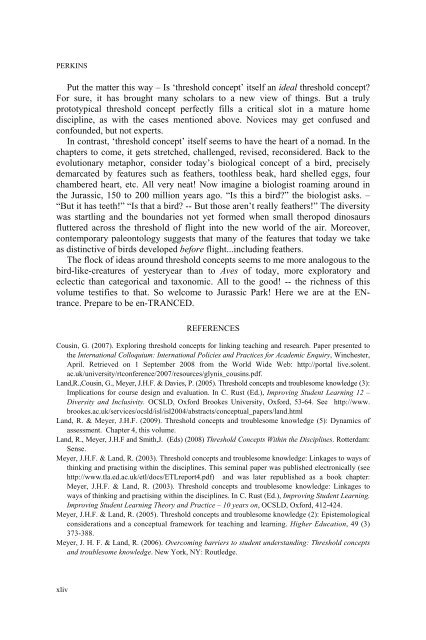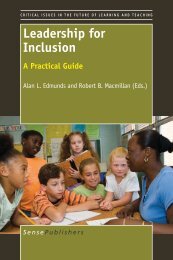1177-threshold-concepts-and-transformational-learning
1177-threshold-concepts-and-transformational-learning
1177-threshold-concepts-and-transformational-learning
- No tags were found...
You also want an ePaper? Increase the reach of your titles
YUMPU automatically turns print PDFs into web optimized ePapers that Google loves.
PERKINSPut the matter this way – Is ‘<strong>threshold</strong> concept’ itself an ideal <strong>threshold</strong> concept?For sure, it has brought many scholars to a new view of things. But a trulyprototypical <strong>threshold</strong> concept perfectly fills a critical slot in a mature homediscipline, as with the cases mentioned above. Novices may get confused <strong>and</strong>confounded, but not experts.In contrast, ‘<strong>threshold</strong> concept’ itself seems to have the heart of a nomad. In thechapters to come, it gets stretched, challenged, revised, reconsidered. Back to theevolutionary metaphor, consider today’s biological concept of a bird, preciselydemarcated by features such as feathers, toothless beak, hard shelled eggs, fourchambered heart, etc. All very neat! Now imagine a biologist roaming around inthe Jurassic, 150 to 200 million years ago. “Is this a bird?” the biologist asks. –“But it has teeth!” “Is that a bird? -- But those aren’t really feathers!” The diversitywas startling <strong>and</strong> the boundaries not yet formed when small theropod dinosaursfluttered across the <strong>threshold</strong> of flight into the new world of the air. Moreover,contemporary paleontology suggests that many of the features that today we takeas distinctive of birds developed before flight...including feathers.The flock of ideas around <strong>threshold</strong> <strong>concepts</strong> seems to me more analogous to thebird-like-creatures of yesteryear than to Aves of today, more exploratory <strong>and</strong>eclectic than categorical <strong>and</strong> taxonomic. All to the good! -- the richness of thisvolume testifies to that. So welcome to Jurassic Park! Here we are at the ENtrance.Prepare to be en-TRANCED.REFERENCESCousin, G. (2007). Exploring <strong>threshold</strong> <strong>concepts</strong> for linking teaching <strong>and</strong> research. Paper presented tothe International Colloquium: International Policies <strong>and</strong> Practices for Academic Enquiry, Winchester,April. Retrieved on 1 September 2008 from the World Wide Web: http://portal live.solent.ac.uk/university/rtconference/2007/resources/glynis_cousins.pdf.L<strong>and</strong>,R.,Cousin, G., Meyer, J.H.F. & Davies, P. (2005). Threshold <strong>concepts</strong> <strong>and</strong> troublesome knowledge (3):Implications for course design <strong>and</strong> evaluation. In C. Rust (Ed.), Improving Student Learning 12 –Diversity <strong>and</strong> Inclusivity. OCSLD, Oxford Brookes University, Oxford, 53-64. See http://www.brookes.ac.uk/services/ocsld/isl/isl2004/abstracts/conceptual_papers/l<strong>and</strong>.htmlL<strong>and</strong>, R. & Meyer, J.H.F. (2009). Threshold <strong>concepts</strong> <strong>and</strong> troublesome knowledge (5): Dynamics ofassessment. Chapter 4, this volume.L<strong>and</strong>, R., Meyer, J.H.F <strong>and</strong> Smith,J. (Eds) (2008) Threshold Concepts Within the Disciplines. Rotterdam:Sense.Meyer, J.H.F. & L<strong>and</strong>, R. (2003). Threshold <strong>concepts</strong> <strong>and</strong> troublesome knowledge: Linkages to ways ofthinking <strong>and</strong> practising within the disciplines. This seminal paper was published electronically (seehttp://www.tla.ed.ac.uk/etl/docs/ETLreport4.pdf) <strong>and</strong> was later republished as a book chapter:Meyer, J.H.F. & L<strong>and</strong>, R. (2003). Threshold <strong>concepts</strong> <strong>and</strong> troublesome knowledge: Linkages toways of thinking <strong>and</strong> practising within the disciplines. In C. Rust (Ed.), Improving Student Learning.Improving Student Learning Theory <strong>and</strong> Practice – 10 years on, OCSLD, Oxford, 412-424.Meyer, J.H.F. & L<strong>and</strong>, R. (2005). Threshold <strong>concepts</strong> <strong>and</strong> troublesome knowledge (2): Epistemologicalconsiderations <strong>and</strong> a conceptual framework for teaching <strong>and</strong> <strong>learning</strong>. Higher Education, 49 (3)373-388.Meyer, J. H. F. & L<strong>and</strong>, R. (2006). Overcoming barriers to student underst<strong>and</strong>ing: Threshold <strong>concepts</strong><strong>and</strong> troublesome knowledge. New York, NY: Routledge.xliv




